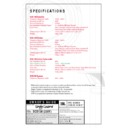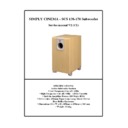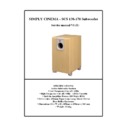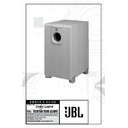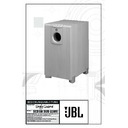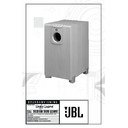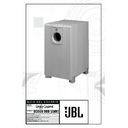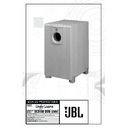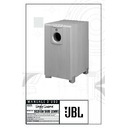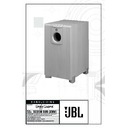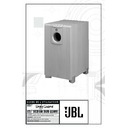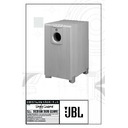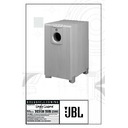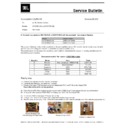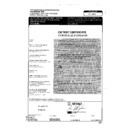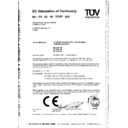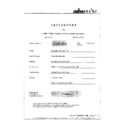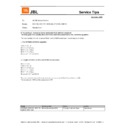JBL SCS 138 Sub (serv.man11) User Manual / Operation Manual ▷ View online
Dolby Pro Logic (Non-Digital) – Line Level
8
Use this installation method
for Dolby Pro Logic appli-
cations (not Dolby Digital,
DTS
for Dolby Pro Logic appli-
cations (not Dolby Digital,
DTS
®
or other digital
processing), where the
receiver/processor is
equipped with a subwoofer
output, or a volume-controlled
receiver/processor is
equipped with a subwoofer
output, or a volume-controlled
preamp (line-) level output:
Use RCA-type patch cords
to connect the line-level
subwoofer outputs on your
receiver or amplifier to the
line-level inputs on the
subwoofer. IMPORTANT: Do
not use the LFE input on the
Use RCA-type patch cords
to connect the line-level
subwoofer outputs on your
receiver or amplifier to the
line-level inputs on the
subwoofer. IMPORTANT: Do
not use the LFE input on the
subwoofer with Dolby
Pro Logic processors. Note: If
your receiver or amplifier only
has one subwoofer output
jack, then you will need to use
a Y-connector (not included).
Plug the male end of the Y-
connector into your receiver
or amplifier’s subwoofer
output jack, and connect each
of the two female ends to
separate RCA-type patch
cords. Finally, plug the RCA-
type patch cords into the line-
level inputs on the subwoofer.
Connect each speaker to the
corresponding speaker
terminals on your receiver or
amplifier.
Pro Logic processors. Note: If
your receiver or amplifier only
has one subwoofer output
jack, then you will need to use
a Y-connector (not included).
Plug the male end of the Y-
connector into your receiver
or amplifier’s subwoofer
output jack, and connect each
of the two female ends to
separate RCA-type patch
cords. Finally, plug the RCA-
type patch cords into the line-
level inputs on the subwoofer.
Connect each speaker to the
corresponding speaker
terminals on your receiver or
amplifier.
Use this installation method for
Dolby Digital, DTS
Dolby Digital, DTS
®
or other
digital surround processors:
Use the line-level input jack
marked “LFE” for the Low-
Frequency Effects channel.
Connect this jack to the LFE
output or subwoofer output
on your receiver or amplifier.
Connect each speaker to the
corresponding speaker
Use the line-level input jack
marked “LFE” for the Low-
Frequency Effects channel.
Connect this jack to the LFE
output or subwoofer output
on your receiver or amplifier.
Connect each speaker to the
corresponding speaker
terminals on your receiver or
amplifier.
Make sure that you have
configured your surround-
sound processor for
“Subwoofer On.” The front left,
front right, center and rear
speakers should all be set to
“Small.”
amplifier.
Make sure that you have
configured your surround-
sound processor for
“Subwoofer On.” The front left,
front right, center and rear
speakers should all be set to
“Small.”
Dolby Digital or DTS
®
(or Other Digital Surround Mode) Connection
LINE LEVEL IN
LFE INPUT
LFE OUT
L
R
SUBWOOFER
RECEIVER
+ –
+ –
+ –
+ –
+ –
+ –
+ –
+ –
+ –
+ –
Receiver
Subwoofer
Out
Left
Front
Left
Rear
Right
Front
Right
Rear
Subwoofer
R L
R
L
Center
Line-
Level
In
Right Surround
Right Front
Left Surround
Left Front
Center
9
O P E R A T I O N
MIN MAX
Subwoofer
Level
MIN MAX
Subwoofer
Level
Press the Master Power
Switch (marked
Switch (marked
Power
¡
) to
the ON position to use the
subwoofer. The subwoofer will
automatically turn itself on or
go into standby (sleep) mode
when left in the standby mode
("Auto/On" switch™
subwoofer. The subwoofer will
automatically turn itself on or
go into standby (sleep) mode
when left in the standby mode
("Auto/On" switch™
™
in the
"Auto" position). When your
receiver or amplifier is off, or is
not sending program material
receiver or amplifier is off, or is
not sending program material
to the subwoofer, the
subwoofer will be in standby
mode. When the subwoofer
senses an audio signal, it will
automatically turn itself on. If
the subwoofer does not sense
a signal after approximately
twenty minutes, it will
automatically go into standby
mode. When the "Auto/On"
switch™
subwoofer will be in standby
mode. When the subwoofer
senses an audio signal, it will
automatically turn itself on. If
the subwoofer does not sense
a signal after approximately
twenty minutes, it will
automatically go into standby
mode. When the "Auto/On"
switch™
™
is switched to the
"On" position, the subwoofer
will remain on, whether or not
program material is playing. If
you will be away from home for
an extended period of time, or
if the subwoofer will not be
used, switch the Master Power
switch
will remain on, whether or not
program material is playing. If
you will be away from home for
an extended period of time, or
if the subwoofer will not be
used, switch the Master Power
switch
¡
to the "OFF" position.
Volume
HIGH LEVEL
+ – – +
CAUTION
RISK OF ELECTRIC SHOCK
DO NOT OPEN
OUT
IN
L R
LINE LEVEL IN
LFE
L
R
AUTO ON
AC 230V~50Hz
200 Watts
IMPORTANT: CONNECT STRIPED WIRE TO RED ( ) SPEAKER TERMINAL.
GREEN: ON
RED: STANDBY
RED: STANDBY
+
Volume can be adjusted using
the Subwoofer Volume Control
£, as shown.
the Subwoofer Volume Control
£, as shown.
The crossover filter between
the subwoofer and satellites
can be adjusted using the
Crossover Control ¢. The
the subwoofer and satellites
can be adjusted using the
Crossover Control ¢. The
optimum setting for the
SCS138 system is with the
Crossover Control ¢ set to
the
SCS138 system is with the
Crossover Control ¢ set to
the
"Max"
position.
™
¢
¡
£
Crossover
10
If there is no sound from any of
the speakers:
• Check that receiver/amplifier
the speakers:
• Check that receiver/amplifier
is on and a source is playing.
• Check that the powered
subwoofer is plugged in, its
Power switch ¡ is switched
on to the
Power switch ¡ is switched
on to the
“ON•”
position, and
the “Auto/On”
switch™
™ is
either in the “On” or “Auto”
position.
position.
• Check all wires and
connections between
receiver/ amplifier and
speakers. Make sure all
wires are connected. Make
sure none of the speaker
wires are frayed, cut or
punctured.
receiver/ amplifier and
speakers. Make sure all
wires are connected. Make
sure none of the speaker
wires are frayed, cut or
punctured.
• Review proper operation of
your receiver/amplifier.
If there is no sound coming
from one speaker:
• Check the “Balance” control
from one speaker:
• Check the “Balance” control
on your receiver/amplifier.
• Check all wires and con-
nections between receiver/
amplifier and speakers. Make
sure all wires are connected.
Make sure none of the
speaker wires are frayed, cut
or punctured.
amplifier and speakers. Make
sure all wires are connected.
Make sure none of the
speaker wires are frayed, cut
or punctured.
• In Dolby Digital or DTS
®
modes, make sure that the
receiver/processor is
configured so that the
speaker in question is
enabled.
receiver/processor is
configured so that the
speaker in question is
enabled.
If there is no sound from the
center speaker:
• Check all wires and
center speaker:
• Check all wires and
connections between
receiver/
amplifier and speaker. Make
sure all wires are connected.
Make sure none of the
speaker wires are frayed, cut
or punctured.
receiver/
amplifier and speaker. Make
sure all wires are connected.
Make sure none of the
speaker wires are frayed, cut
or punctured.
• If your receiver/processor is
set in Dolby Pro Logic mode,
make sure the center
speaker is not in phantom
mode.
make sure the center
speaker is not in phantom
mode.
• If your receiver/processor
is set in Dolby Digital or DTS
®
mode, make sure the
receiver/processor is con-
figured so that the center
speaker is enabled.
receiver/processor is con-
figured so that the center
speaker is enabled.
If the system plays at low
volumes but shuts off as
volume is increased:
• Check all wires and connecti-
volumes but shuts off as
volume is increased:
• Check all wires and connecti-
ons between receiver/
amplifier and speakers. Make
sure all wires are connected.
Make sure none of the
speaker wires are frayed, cut
or punctured.
amplifier and speakers. Make
sure all wires are connected.
Make sure none of the
speaker wires are frayed, cut
or punctured.
• If more than one pair of main
speakers is being used,
check the minimum
impedance requirements of
your receiver/amplifier.
check the minimum
impedance requirements of
your receiver/amplifier.
If there is low (or no) bass
output:
• Make sure the connections
output:
• Make sure the connections
to the left and right “Speaker
Inputs” have the correct
polarity (+ and –).
Inputs” have the correct
polarity (+ and –).
• Make sure the subwoofer is
plugged into an active
electrical outlet.
electrical outlet.
• Make sure the powered
subwoofer is plugged in and
is either in the “On” or
“Auto” position.
is either in the “On” or
“Auto” position.
• In Dolby Digital or DTS
®
modes, make sure your
receiver/processor is
configured so that the
subwoofer and LFE output
are enabled.
receiver/processor is
configured so that the
subwoofer and LFE output
are enabled.
If there is no sound from the
surround speakers:
• Check all wires and
surround speakers:
• Check all wires and
connections between
receiver/ amplifier and
speakers. Make sure all
wires are connected. Make
sure none of the speaker
wires are frayed, cut or
punctured.
receiver/ amplifier and
speakers. Make sure all
wires are connected. Make
sure none of the speaker
wires are frayed, cut or
punctured.
• Review proper operation of
your receiver/amplifier and
its surround-sound features.
its surround-sound features.
• Make sure the movie or TV
show you are watching is
recorded in a surround-
sound mode. If it is not, check
to see if your receiver/
amplifier has other surround
modes you may use.
recorded in a surround-
sound mode. If it is not, check
to see if your receiver/
amplifier has other surround
modes you may use.
• In Dolby Digital or DTS
®
modes, make sure your
receiver/processor is
configured so that the
surround speakers are
enabled.
receiver/processor is
configured so that the
surround speakers are
enabled.
• Review the operation of your
DVD player and the jacket of
your DVD to make sure that
the DVD features the desired
Dolby Digital or DTS
your DVD to make sure that
the DVD features the desired
Dolby Digital or DTS
®
mode,
and that you have properly
selected that mode using
both the DVD player’s menu
and the DVD disc’s menu.
selected that mode using
both the DVD player’s menu
and the DVD disc’s menu.
T R O U B L E S H O O T I N G
11
Staple sales invoice here.

